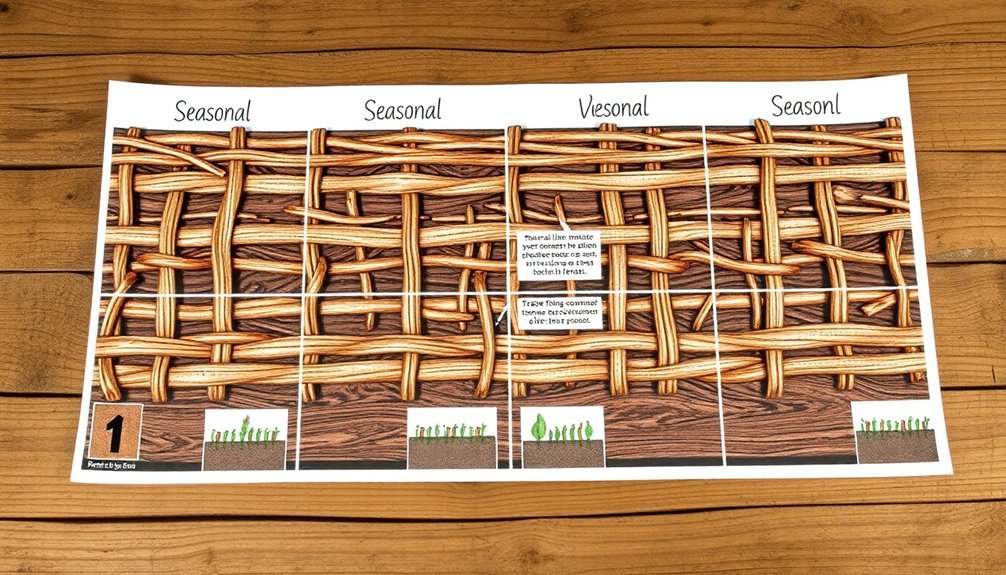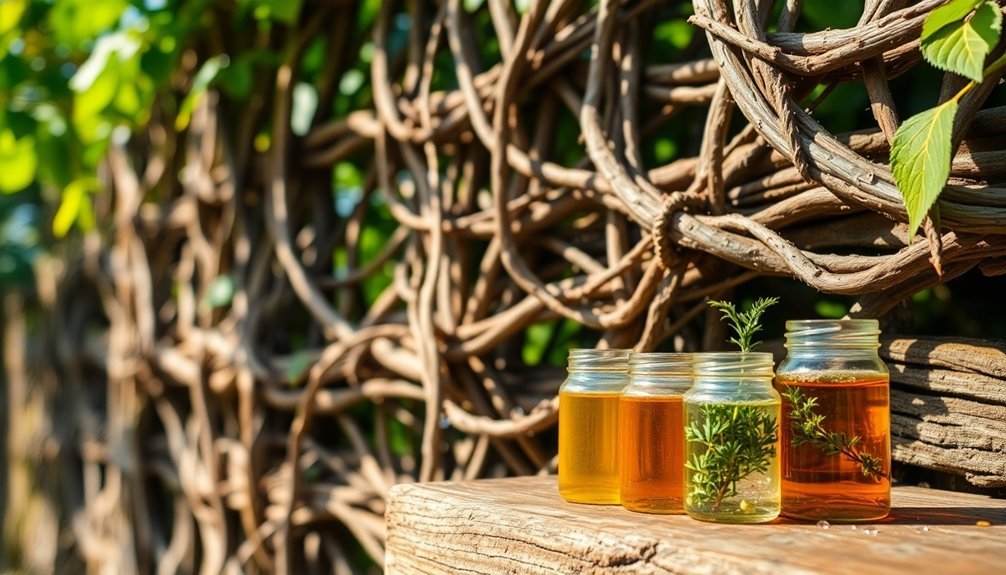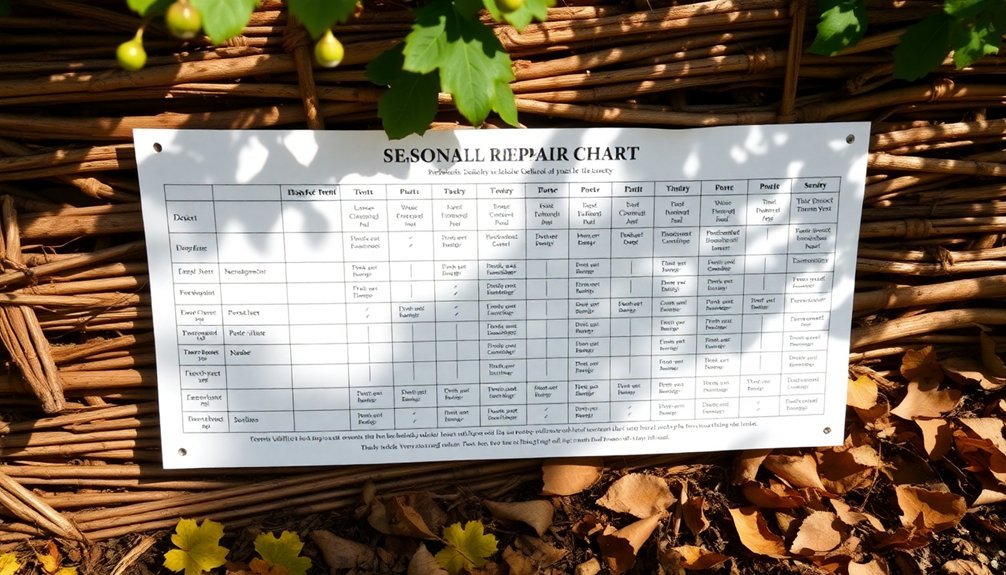Wattle fences need seasonal care to maintain their rustic charm and structural integrity. In winter, check for moisture damage and gaps from shrinking branches. Spring calls for weaving fresh branches into weak spots and applying natural protective coatings. Summer is ideal for reinforcing sagging sections with additional stakes. Fall requires preparation with preservatives like linseed oil to weather the coming winter. Your fence's longevity depends on this quarterly rhythm of assessment and targeted repairs.
Understanding Wattle Fence Structures and Common Weaknesses

Craftsmanship meets nature in the elegant simplicity of wattle fencing. These traditional structures consist of flexible branches like willow or hazel woven between sturdy stakes driven about 12 inches apart in the ground, creating a distinctive crisscross pattern.
Despite their rustic charm, wattle fences face predictable challenges. Weather cycles cause the wood to expand and contract, potentially weakening the structure over time. You'll notice stakes loosening in the soil and gaps forming as branches naturally shrink. Applying a protective linseed oil mixture annually can significantly extend the lifespan of your wattle fence.
Nature's cycles test wattle fences as wood expands, contracts, and shrinks, gradually weakening these charming yet vulnerable structures.
Heavy climbing plants can strain the weave, while insects may take up residence in untreated wood. Understanding these inherent weaknesses helps you anticipate problems before they compromise your fence's integrity.
Regular inspection of posts, weaving patterns, and surrounding vegetation will guide your maintenance efforts throughout the seasons.
Winter Damage Assessment for Woven Branch Barriers
Winter reveals the true resilience of your wattle fence, often exposing weaknesses that remain hidden during milder seasons. Look for moisture damage where snow and ice have penetrated the weave, causing branches to expand and contract.
Check posts for stability issues from freeze-thaw cycles that shift the soil beneath. Thawing can create soil displacement around posts that compromises your wattle fence's structural integrity.
Examine your fence for specific winter-related problems: heaving posts that have risen from frost action, split wood from temperature fluctuations, and gaps created by branch shrinkage.
Don't overlook signs of animal activity—gnaw marks or burrowing around the base indicate creatures seeking winter shelter.
After heavy snow or storms, assess for structural wear where excessive weight may have caused sagging or breakage in the woven pattern.
Prompt identification of these issues will guide your repair strategy.
Spring Rejuvenation Techniques for Weather-Worn Wattle

As spring unfolds, your winter-battered wattle fence deserves dedicated attention to restore its strength and charm. This season offers the perfect opportunity to address weakened areas and reinforce the natural structure before summer growth begins. Properly maintained wattle fencing can provide lasting protection for your garden for up to a decade with proper care.
- Begin by weaving fresh flexible branches like willow or hazel into gaps that formed during winter months.
- Apply natural protective coatings such as linseed oil to shield wood from moisture and extend its lifespan.
- Reinforce corner posts and gates with additional support stakes to improve overall stability.
- Trim back heavy climbing plants that may have weakened sections of your fence during winter.
- Fill small gaps with thin, pliable branches to restore the fence's integrity and maintain its traditional aesthetic.
Summer Reinforcement Methods for Sagging Sections
During the heat of summer months, wattle fences often develop noticeable sagging sections that require prompt attention before they compromise the entire structure.
Identify weak areas and assess material condition—looking specifically for rot or insect damage.
Drive additional support stakes alongside sagging sections, ensuring they're firmly anchored in stable ground.
Tighten loose weaving patterns by adding fresh willow or hazel branches, which remain pliable during summer. Secure these with natural twine or discreet wire connections. Similar to four selvedge tapestry weaving, maintaining proper tension throughout helps preserve structural integrity.
For severely damaged sections, don't hesitate to replace rotted wood with redwood or cedar alternatives that resist decay.
Consider elevating fence bottoms with brick barriers if standing water is an issue.
Remember to wear protective gloves during repairs, as dried wattle can splinter easily in summer's low humidity.
Fall Preparation to Strengthen Against Coming Weather

Fall preparation becomes essential as temperatures begin to drop and autumn winds threaten the integrity of wattle fencing structures.
Start by thoroughly inspecting your fence for loose weaving and damaged posts, addressing issues before harsh weather arrives. Clear debris around posts to improve drainage and prevent rot when autumn rains begin. Consider adding a fresh 3-inch layer of drainage gravel around each post base to prevent water collection.
- Apply a natural wood preservative to extend your fence's lifespan through winter
- Trim any sprouted branches from green wood to maintain the fence's appearance
- Check support posts for rot and repair immediately to guarantee stability
- Reinforce sections vulnerable to strong winds with additional weaving
- Create proper drainage channels around posts to prevent freeze damage
Remember to perform these tasks before the first frost for ideal protection against winter conditions.
Essential Tools and Materials for Seasonal Wattle Repairs
Keeping your weaving tools handy—including pruning shears, rubber hammers, and drills—will make your seasonal wattle repairs much easier to complete.
Natural materials like willow, hazel, and bamboo offer excellent flexibility for addressing winter damage or reinforcing weak spots in your fence.
You'll also want to contemplate weather-resistant sealants to protect your newly repaired sections from the upcoming season's rain, snow, or sun exposure.
Pine branches provide a rustic appearance while being readily available for most DIY fence repair projects.
Seasonal Weaving Tools
When repairing wattle fences throughout the year, you'll need a specific arsenal of tools tailored to the changing seasons. Your weaving toolkit should adapt to various weather conditions and branch flexibility.
- Spring/Summer: Prioritize secateurs and loppers when branches are pliable; keep a soaking tub handy for drier materials. Seeking out green wood from local sources will provide optimal flexibility for your repair work.
- Fall: Add a leaf blower to clear debris from your work area and guarantee clean weaving patterns.
- Winter: Include wood preservatives and natural oils to protect newly woven sections from frost damage.
- Year-round: Maintain a hurdle jig for consistent fence height and a straight edge for precise branch cutting.
- Transitional seasons: Use rope or twine to temporarily secure branches while they settle into position.
Natural Repair Materials
Selecting the right natural materials forms the foundation of effective wattle fence repairs, regardless of which season you're working in.
Flexible branches from willow or hazel provide ideal weaving material, while rot-resistant oak or cedar makes excellent replacement stakes.
For gaps and weatherproofing, consider natural alternatives like daub (a simple soil-water mixture) or plant-based resins.
Apply natural wood oils annually to protect against weathering and extend your fence's life.
Don't overlook sustainable options like bamboo for reinforcement or repurposed materials from old pallets.
For pest prevention, cedar chips around the base serve as natural deterrents, while proper mulching helps manage moisture levels.
When installing new posts, add gravel for improved drainage and stability—this simple step can greatly extend your fence's durability.
Having a small hand saw ready ensures you can quickly trim branches to the perfect length during your repair session.
Weather-Resistant Sealants
To safeguard your wattle fence against the elements, weather-resistant sealants serve as your primary defense line throughout the seasons.
Choose clear sealants or tinted stains based on your aesthetic preference, ensuring they contain moisture and UV-repelling ingredients for maximum protection.
Apply your chosen sealant when the fence is completely dry, using thin, even coats in the direction of the wood grain.
For thorough protection, you'll need to tailor your application schedule to the seasons.
- Spring: Reapply sealants when branches are pliable, focusing on winter-damaged areas
- Summer: Use UV-resistant products to prevent sun damage
- Fall: Clean and reseal to prepare for winter moisture
- Winter: Conduct regular inspections for damage
- Base areas: Pay extra attention where moisture accumulates
For optimal results, focus particularly on areas where boards meet posts as these junctions are especially vulnerable to moisture infiltration that can accelerate deterioration.
Weaving Replacement Branches: Step-by-Step Techniques
The art of weaving replacement branches forms the heart of successful wattle fence repair. Begin at the bottom of your fence, overlapping branches slightly as you weave. Maintain a consistent pattern—behind one picket, in front of the next—to guarantee structural integrity.
As you work, periodically compact the woven sections for stability. Tuck branch ends securely into the fence to maintain a neat appearance. When you need to add new branches, start them just above the last one to preserve the fence's strength. Just as with rigid heddle weaving, creating the right open shed between elements allows for proper integration of new materials.
For thinner areas, consider braiding multiple slim branches together to create thicker weavers. Remember to follow your fence's existing pattern and height.
Don't rush the process—proper weaving technique now will prevent repairs later and extend your wattle fence's lifespan considerably.
Natural Preservatives to Extend Your Wattle Fence Lifespan

You'll considerably extend your wattle fence's life with traditional linseed oil, which prevents rot and weathering when applied annually.
Natural beeswax creates a protective moisture barrier that keeps your fence sturdy through changing seasons while repelling destructive insects.
Utilizing pruned branches from your fruit trees provides sustainable materials for repairs while maintaining the authentic appearance of your wattle fence.
Vinegar-based solutions offer an eco-friendly way to clean and prepare your fence before applying preservatives, ensuring better absorption and maximum protection.
Linseed Oil Benefits
Linseed oil stands as an exceptional natural preservative for wattle fences, offering robust protection against nature's harshest elements.
You'll find this natural solution extends your fence's lifespan by 2 to 3 years when applied properly on clean, dry surfaces. For best results, apply it twice yearly—before summer and winter—using a 50:50 mix with clear wood preserve for enhanced protection.
- Prevents wood brittleness and cracking from sun exposure
- Requires only 1L to treat approximately 5m² of fence surface
- Can be thinned with white spirit for easier application
- Dries completely within 24 hours, creating a safe barrier
- Combats weather-related deterioration when regularly applied
Remember to apply in well-ventilated areas and verify the fence is completely dry before treatment for maximum absorption.
Natural Beeswax Applications
Alongside linseed oil, natural beeswax offers an outstanding preservation method for wattle fences that gardeners have trusted for centuries. This non-toxic substance creates a protective moisture barrier while allowing your wood to breathe naturally.
To prepare your own preservative, gently melt beeswax and blend it with jojoba or coconut oil for better absorption. Apply thoroughly to both the frame and woven elements using a brush or cloth. For maximum protection, add UV inhibitors to prevent sun damage.
Unlike chemical treatments, beeswax won't release harmful fumes or damage your garden ecosystem. The wattle structure provides excellent pet containment while maintaining its aesthetic appeal.
You'll need to reapply seasonally—particularly before winter to shield against moisture and after spring cleaning to restore protection. Your fence will develop a warm, subtle glow while gaining significant protection from rot and decay.
Vinegar-Based Solutions
While vinegar offers many uses in the garden, its application for wattle fence preservation remains limited compared to other natural treatments. You'll find vinegar works better as a tool sanitizer when preparing materials for fence repair rather than as a direct preservative.
The acidic nature of vinegar can potentially disrupt soil pH if overused near your fence line. For more sustainable results, select young flexible branches from maple, hazel, or willow trees when repairing your wattle fence sections.
- Use vinegar primarily to clean and disinfect tools before cutting new wattle materials
- Apply vinegar-steel wool solutions sparingly if staining is desired, not as a primary preservative
- Consider oak or cedar as naturally weather-resistant alternatives that don't require vinegar treatment
- Keep vinegar solutions away from plant roots surrounding your fence structure
- Reserve vinegar treatments for specific fungal issues on nearby plants rather than on the fence itself
Post Stability: The Foundation of Wattle Fence Longevity

When your wattle fence begins to sag or wobble, the culprit is almost always unstable posts. Check for signs of rot, softness, or discoloration that indicate compromised integrity.
Posts should be installed at least 2 feet deep, spaced 8-12 inches apart, using weather-hardy woods like oak or cedar. For maximum stability, pack gravel at the base for drainage and add concrete for reinforcement.
Conduct seasonal inspections, especially in spring after frost cycles. Don't let soil, debris, or excessive plant growth accumulate around posts, as these accelerate rot. Apply natural oils annually as protective coating.
If you discover loose posts, reinforce them with metal brackets or additional concrete. For severely damaged posts, replace them during mild weather, ensuring proper integration with your existing wattle weaving.
Creating Your Custom Year-Round Maintenance Calendar
A well-maintained wattle fence requires systematic care throughout the year, not just sporadic attention when problems arise.
Consistent year-round attention, not reactive fixes, ensures your wattle fence stands the test of time.
Creating a personalized maintenance calendar guarantees you'll address essential tasks at ideal times, extending your fence's lifespan while minimizing repair costs.
- Monthly: Conduct visual inspections, gently clean with a soft brush, and rinse with water to prevent dirt buildup.
- Quarterly: Check hardware connections, inspect for pest activity, and trim encroaching vegetation.
- Biannually: Apply natural sealants during dry weather and document any structural changes.
- Seasonally: Remove fall debris, clear winter snow loads, check for spring moisture damage, and protect against summer UV exposure.
- Annually: Perform thorough structural assessment, replacing damaged materials with matching components.
Track your maintenance history to identify recurring issues that might indicate deeper problems requiring professional attention.
Frequently Asked Questions
How Long Does a Typical Wattle Fence Last Before Major Replacement?
Your wattle fence typically lasts 8-15 years before needing major replacement. You'll extend its life if you use durable materials like hazel or willow and perform regular maintenance checks throughout the seasons.
Can I Use Synthetic Materials to Reinforce Traditional Wattle Construction?
Yes, you can use synthetic materials like plastic poles or metal supports to reinforce traditional wattle fencing. They'll increase durability and weather resistance while requiring less maintenance, though they might affect the natural aesthetic you're seeking.
Are There Eco-Friendly Alternatives to Chemical Preservatives for Wattle?
Yes, you can use cedar oil, linseed oil, beeswax, or vinegar as eco-friendly preservatives. Choose naturally resistant woods like oak or cedar, and implement regular maintenance to extend your wattle fence's lifespan without chemicals.
How Do Wildlife Interactions Affect Wattle Fence Durability?
Wildlife interactions can weaken your wattle fence. Small animals like ducks won't cause much damage, but larger wildlife may break woven sections. You'll need more frequent repairs if wildlife regularly contact your fence.
What Landscaping Complements Wattle Fences While Enhancing Their Stability?
You'll enhance your wattle fence's stability and appeal by planting climbing roses or clematis with stone bases underneath. Add gravel for drainage, install metal stakes for support, and use sedum as drought-tolerant ground cover.
In Summary
With seasonal care, you'll extend your wattle fence's life for years to come. Remember, it's easier to fix small issues before they become major problems. Keep this repair chart handy and follow your personalized maintenance calendar. By addressing winter damage, spring rejuvenation, summer reinforcement, and fall preparation, you're not just maintaining a fence—you're preserving a traditional craft that connects you to the land.





Leave a Reply